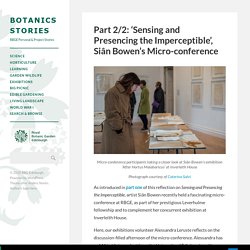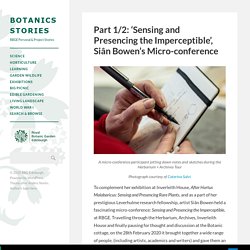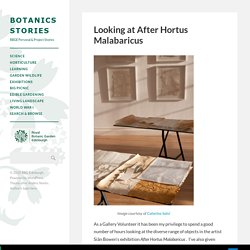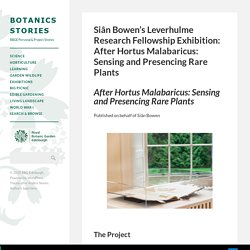

Sensing and Presencing Rare Plants through Contemporary Drawing Practice. Blog post contributed by Sian Bowen, Leverhulme Fellow & Reader in Fine Art at the University of Northumbria, www.sianbowen.com With support from a Leverhulme Trust Research Fellowship, I am currently developing a project, Sensing and Presencing Rare Plants through Contemporary Drawing Practice, which investigates how the materiality of drawing can make present the imperceptible nature of the vulnerabilities and resilience of rare plants.

As an artist, this builds on my ongoing interest in the ways in which drawing might convey states of flux. Although I would strongly advocate that drawing can be made on any surface and in any medium, paper plays a crucial role in this project. The resulting artworks will form an exhibition which will be staged in the UK and India in 2019. Hortus Indicus Malabaricus. By ‘This part of India was truly and rightly the most fertile part of the whole world’.

Rheede tot Drakenstein, Preface to volume 3 of the Hortus Malabaricus, p. v. Prior to his appointment as Commander of Malabar in 1670, Hendrik Adriaan van Reede tot Drakenstein (1636-1691) had had a lively military career as part of the Dutch East India Company. He had served in the Cape of Good Hope and Batavia, Ceylon and the Malabar but it was in the Malabar that van Reede really made his mark.
Having restored order by 1674 van Reede turned his attention to botany. Rheede tot Drakenstein, Hortus Indicus Malabaricus (Amsterdam, 1673-1703) vol 1, Fig 16. Differences with the Governor of Ceylon, Rijcklof van Goens (who subsequently became the Governor-General of the Dutch East Indies) led to his departure from the Malabar in 1677 and had a major impact on his subsequent career.
Part 2/2: ‘Sensing and Presencing the Imperceptible’, Siân Bowen’s Micro-conference. As introduced in part one of this reflection on Sensing and Presencing the Imperceptible, artist Siân Bowen recently held a fascinating micro-conference at RBGE, as part of her prestigious Leverhulme fellowship and to complement her concurrent exhibition at Inverleith House.

Here, our exhibitions volunteer Alessandra Leruste reflects on the discussion-filled afternoon of the micro-conference. Alessandra has an MA in History of art from the University of Edinburgh and has been volunteering at Inverleith House for half a year. I volunteer at Inverleith House and have spent a lot of time in the rooms of Siân Bowen’s After Hortus Malabaricus: Sensing and Presencing the Imperceptible. I am convinced this is the best way to enjoy the exhibition: come back every day until the end of the exhibition, see it under as many lights as the month of March has to offer, move around, take your time. This is our privilege as volunteers; we get to build our own long-term relationship with the shows.
Dr. Part 1/2: ‘Sensing and Presencing the Imperceptible’, Siân Bowen’s Micro-conference. To complement her exhibition at Inverleith House, After Hortus Malabaricus: Sensing and Presencing Rare Plants, and as a part of her prestigious Leverhulme research fellowship, artist Siân Bowen held a fascinating micro-conference: Sensing and Presencing the Imperceptible, at RBGE.

Travelling through the Herbarium, Archives, Inverleith House and finally pausing for thought and discussion at the Botanic cottage, on the 28th February 2020 it brought together a wide range of people, (including artists, academics and writers) and gave them an opportunity to learn more about Bowen’s research, share their thoughts about the exhibition, and explore notions of imperceptibility. Klaudia Jaworska is in her third year at Edinburgh Napier University, studying International Festivals and Events Management and Marketing.
As part of her course, she is currently carrying out a work placement in RBGE’s Public Engagement Department. Huge, tropical plants can also be found in the RBGE Herbarium. Hortus Malabaricus (1678-1693) Looking at After Hortus Malabaricus. As a Gallery Volunteer it has been my privilege to spend a good number of hours looking at the diverse range of objects in the artist Siân Bowen’s exhibition After Hortus Malabaricus .

I’ve also given some short talks on the exhibition based on what I have learned from the artist and my own observations and thoughts. So this is my take on it. The exhibition looks at a particular set of Indian plants in new ways. Siân Bowen’s Leverhulme Research Fellowship Exhibition: After Hortus Malabaricus: Sensing and Presencing Rare Plants. Published on behalf of Siân Bowen The Project Introduction After Hortus Malabaricus: Sensing and Presencing Rare Plants marks the culmination of my four-year collaboration with the Herbarium at the Royal Botanic Garden Edinburgh (RBGE).

Having held my first solo exhibition in Scotland at Inverleith House at RBGE in 1995, it is wonderful to be able to exhibit here once again. In 2017, I was awarded a Leverhulme Research Fellowship to carry out the project. Context Plants have been a ‘currency’ of empires, their collection and distribution having had huge social, cultural and political implications. Hortus Malabaricus took nearly thirty years to compile. Sian Bowen and Hortus Malabaricus. The collection and distribution of plants – once a currency of empires – still has huge social, cultural and political implications today.

Thousands of species are identified as endangered or possibly extinct, while bans on the transportation of plant specimens guard against bioprospecting and biopiracy. This, together with significant contemporary interest in drawing in its broadest terms and in the sensory nature of museum objects, opens a clear position for my investigation at the interstices of fine art, botany and plant science, museology and cultural geography. Historically, drawing has been the key means of scientific description and identification of plants. With digital technologies now occupying this central position, my project asserts that botanical illustrations and specimens are now inspiring contemporary art practices, especially those concerned with themes of ephemerality.
Some pictures from the wonderful exhibition 'After Hortus Malabaricus: Sensing and Presencing Rare Plants' by Siân Bowen at Inverleith House. □□□ For more information about the exhibition.